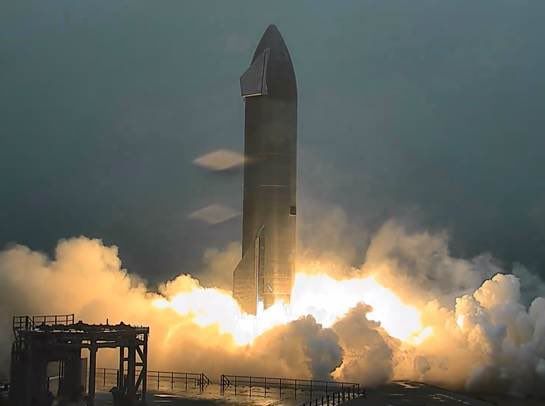SpaceX now targeting Monday for Starship SN9 test flight

We’ll have to wait until next month to see SpaceX’s latest Starship prototype fly.
The company is now targeting Monday (Feb. 1) for a highly anticipated test flight that will send its stainless-steel Starship SN9 vehicle soaring about 6.2 miles (10 kilometers) into the South Texas skies.
SpaceX had aimed to launch SN9 yesterday (Jan. 28) but did not receive the necessary approval in time from the U.S. Federal Aviation Administration (FAA), which cited an ongoing safety review.
Starship and Super Heavy: SpaceX’s Mars-colonizing vehicles in images
“We will continue working with SpaceX to resolve outstanding safety issues before we approve the next test flight,” an FAA spokesperson told Space.com yesterday in an emailed statement, without specifying what those issues are.
The delay apparently didn’t sit well with SpaceX founder and CEO Elon Musk, who is known for setting aggressive and ambitious timelines for his many projects. (He recently said, for example, that he expects Starship to be carrying people to Mars by 2026, and that this milestone could even happen by 2024 “if we get lucky.”)
“Unlike its aircraft division, which is fine, the FAA space division has a fundamentally broken regulatory structure. Their rules are meant for a handful of expendable launches per year from a few government facilities. Under those rules, humanity will never get to Mars,” Musk said via Twitter yesterday.
Musk and SpaceX apparently held out some hope that the necessary approval could come in time for a launch today (Jan. 29): Residents of Boca Chica Village, the Gulf Coast hamlet adjacent to the SpaceX site, were reportedly told to evacuate this morning. But those evacuation orders were later rescinded, and the flight will now officially occur no earlier than Monday.
There’s no guarantee that the FAA approval will come by then, however.
“The FAA will continue to work with SpaceX to evaluate additional information provided by the company as part of its application to modify its launch license,” an FAA spokesperson said in another emailed statement, this one sent out this afternoon.
“While we recognize the importance of moving quickly to foster growth and innovation in commercial space, the FAA will not compromise its responsibility to protect public safety,” the statement continues. “We will approve the modification only after we are satisfied that SpaceX has taken the necessary steps to comply with regulatory requirements.”
The Starship architecture consists of two elements, both of which are designed to be fully and rapidly reusable: A 165-foot-tall (50 meters) spacecraft called Starship and a huge rocket known as Super Heavy. Both will be powered by SpaceX’s next-generation Raptor engines — six for Starship and about 30 for Super Heavy, which will get the spacecraft off Earth. (Starship will be powerful enough to launch itself off the moon and Mars, Musk has said.)
SN9 has three Raptors, just like its predecessor, the SN8 vehicle, which last month performed the Starship program’s first-ever high-altitude hop. SN8 flew extremely well, checking off every box except the final one; the vehicle came down at its designated landing site a bit too fast and exploded in a dramatic fireball.
Starship SN10 is about to leave the production site. ???@NASASpaceflight pic.twitter.com/hsIwGOY32MJanuary 29, 2021
SN9 won’t be the last Starship prototype to get off the ground. Indeed, SpaceX just rolled the SN10 vehicle toward the launch pad, where it will soon begin its prelaunch checkouts.
Editor’s note: This story was updated at 5 p.m. EST on Friday (Jan. 29) to include a new statement from the FAA.
Mike Wall is the author of “Out There” (Grand Central Publishing, 2018; illustrated by Karl Tate), a book about the search for alien life. Follow him on Twitter @michaeldwall. Follow us on Twitter @Spacedotcom or Facebook.
